The coronavirus pandemic has been a shock to people across all aspects of everyday living, for older and younger people, for work and school, for entertainment and travel — all impacting our hearts, minds, and wallets.
“As the bedrock of daily life was shaken, uncertainty predictably emerged as the prevailing emotion of our time but this universal problem was eliciting a highly differentiated reaction in different people,” Kern Schireson, CEO of Known, observed.
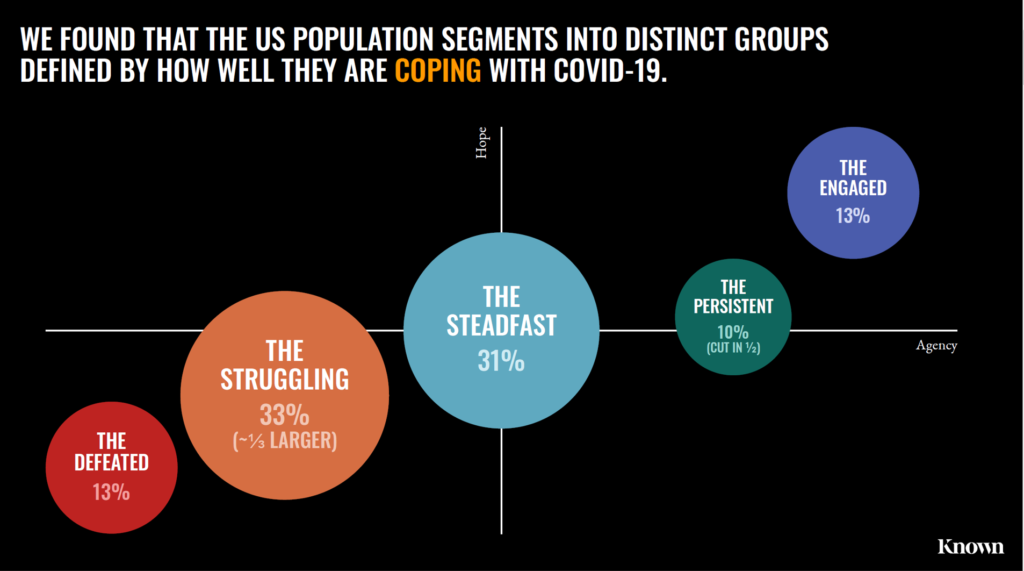 His company has conducted a large quantitative and qualitative research program culminating in a first report, The Human Condition 2020: A Shock To The System. Known’s team of marketers has explored the perspectives 1,795 U.S. adults between 13 and 71 years of age in the first phase of the COVID-19 pandemic.
His company has conducted a large quantitative and qualitative research program culminating in a first report, The Human Condition 2020: A Shock To The System. Known’s team of marketers has explored the perspectives 1,795 U.S. adults between 13 and 71 years of age in the first phase of the COVID-19 pandemic.
The research has uncovered differences in peoples’ resilience and response to the public health crisis and its economic, social, clinical, and emotional impacts. But these factors did not interact in ways we might have predicted; the data revealed five consumer segments based on how well people have been coping with COVID-19. These are:
- The Engaged, 13% of the population
- The Persistent, 10%
- The Steadfast, 31%
- The Struggling, 33%; and
- The Defeated. 13% of people.
One over-arching finding covers most of the humans “shocked” by the pandemic: that only 13% of Americans see their lives going back to the way they were before the coronavirus pandemic emerged. In short: 2021 and beyond will be different than 2019.
I am grateful to the Known team for sharing details of these findings with me to now share with Health Populi readers. In response to a question I asked them about what factors most influenced resilience in the pandemic, they responded with amazing and insightful details discussed here.
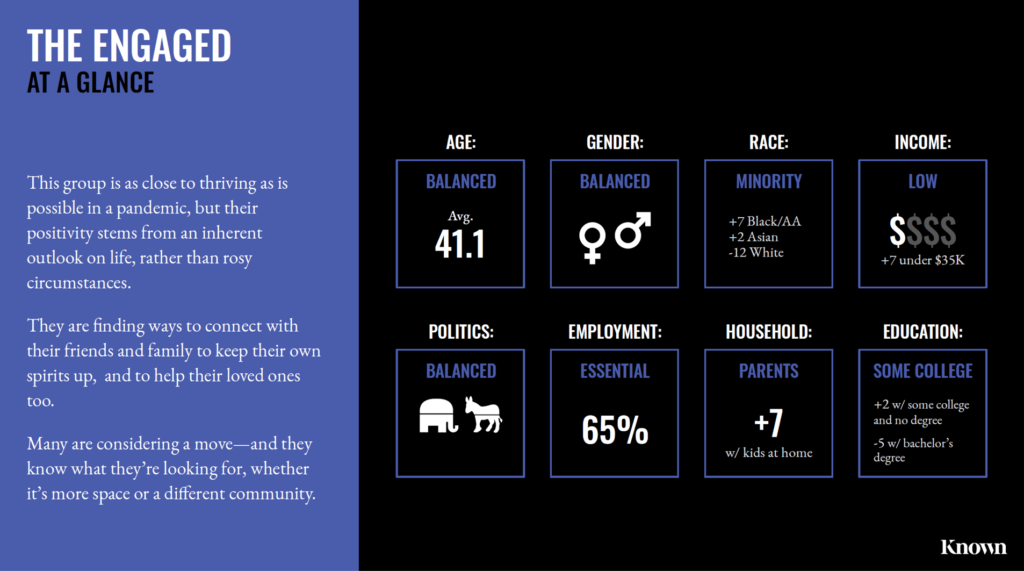 As the x-y graph illustrates here, the five segments are based on two key traits of coping: agency and hope. “Agency” in its social science definition is the capacity for a person to act independently and make free choices.
As the x-y graph illustrates here, the five segments are based on two key traits of coping: agency and hope. “Agency” in its social science definition is the capacity for a person to act independently and make free choices.
For a definition of “hope,” I turned to the classed Merriam-Webster dictionary for some context to array with its x-axis partner, agency. Hope as a verb can mean,
- To cherish a desire with anticipation
- To want something to happen or be true
- To expect with confidence.
In Merriam-Webster’s definition, trust underpins these hope definitions.
Here, I’ll compare to two extremes of the five people-segments: The Engaged and The Defeated.
The Engaged sit at the upper right corner of the matrix with the greatest levels of agency and hope. Based on the data, Known observes that the Engaged are, “as close to thriving as is possible in a pandemic,” but this positive outlook is based more on peoples’ outlook on life and not based on “rosy circumstances” like high incomes and post-graduate college degrees.
In fact, this group — people who feel the most agency and hope — tend to find ways to connect with friends and family. They index higher for having children at home, earn lower incomes, and be more likely to be Black than White.
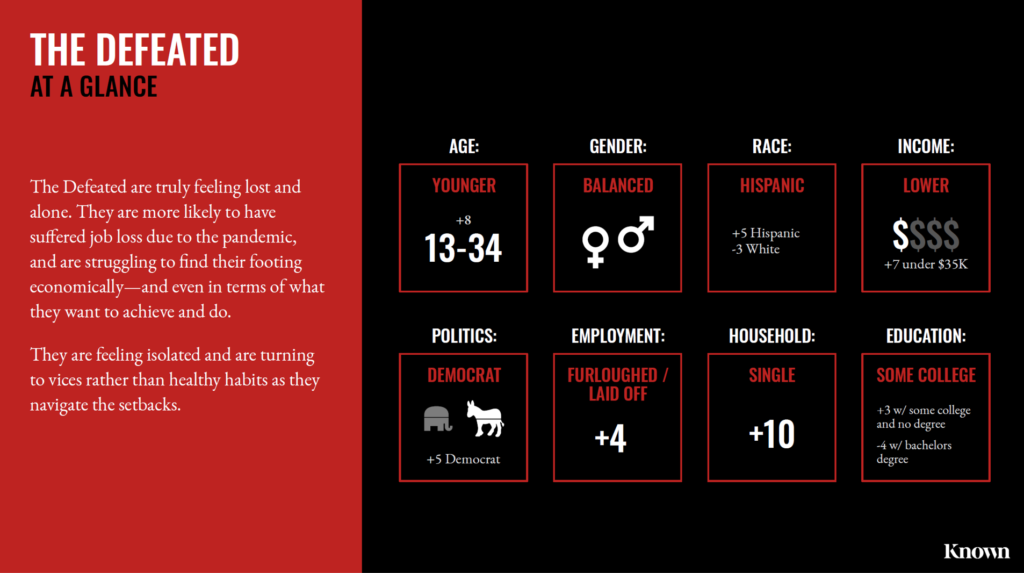 People in The Defeated group more likely lost a job in the pandemic and tend to feel “lost and alone,” based on Known’s read. People feeling less agency and hope are also “turning to vices” and less healthy habits, according to the research, tend to be younger and living alone. This group indexes higher among Hispanic people.
People in The Defeated group more likely lost a job in the pandemic and tend to feel “lost and alone,” based on Known’s read. People feeling less agency and hope are also “turning to vices” and less healthy habits, according to the research, tend to be younger and living alone. This group indexes higher among Hispanic people.
In-between these two extremes are:
The Persistent, with greater agency than hope, feeling knocked off-course according to Known. But as they are younger with ambition, higher income, and many in school, they remain resilient and “persistent” to move forward.
The Steadfast, at the center of the matrix, who are confident they can return to a “normal” compared with other people. These tend to be folks working in white collar jobs, making more money, with college degrees, these people aren’t making as many changes in their lives as others.
Finally, The Struggling folks are older, challenged with health issues, economic uncertainty, and loneliness. The Struggling folks tend to be older, earning middle-incomes, more likely divorced, White, and leaning Democrat in terms of politics.
A few themes emerged across all of us dealing with pandemic in the U.S.:
- Most teens are feeling detached and isolated, while also being “obsessed with screens” (Known’s words), mindful and concerned with that digital attachment; students feel very detached and isolated from school and friends
- More women tele-working from home have been doing this for the first time compared with men
- Younger working professionals believe the pandemic has stalled their professional development
- Exercise in the future may evolve to be a solo sport: a large percentage of people do not plan to return to the gym, echoed in other research conducted during the pandemic.
Two other changes we’ll watch for over time: peoples’ views on their local community, focusing more on a “hyper-local” approach to consumption and retail; and, consumers looking to change their physical housing situation, looking to move “further out,” expand space, or re-define their role in their neighborhoods and communities.
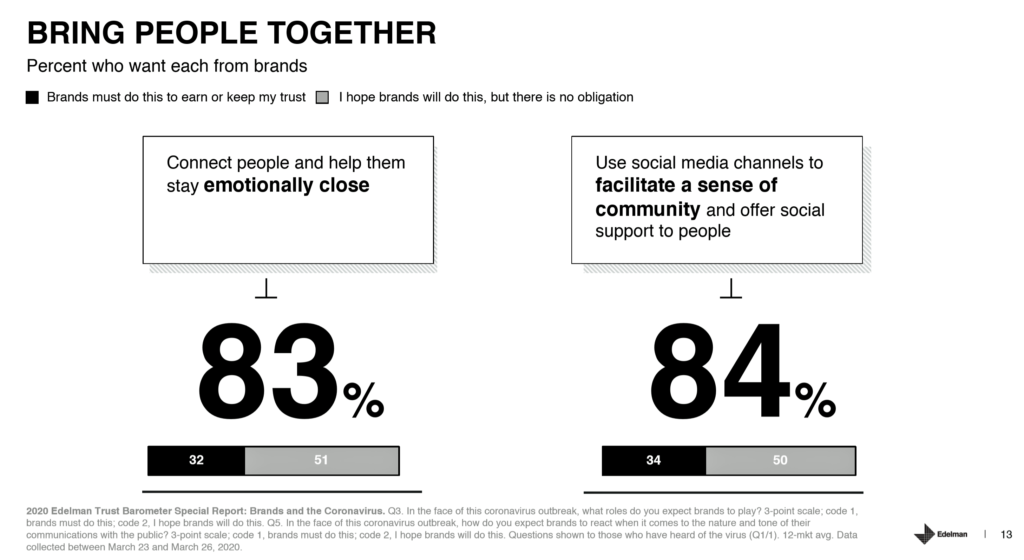 Health Populi’s Hot Points: This first wave of Known’s research raises so many issues for public and individual health, physical and mental health, and social and civic health.
Health Populi’s Hot Points: This first wave of Known’s research raises so many issues for public and individual health, physical and mental health, and social and civic health.
Among all of these, I return to the Merriam-Webster inclusion of “trust” in its definition of “hope.”
Consumers’ and citizens’ trust have been eroding in the U.S., and indeed globally, for several years. In April in the second month of the pandemic, I discussed Edelman’s latest Trust Barometer which focused in on the trust-impacts of COVID-19 around the world.
As trust between citizens and their governments, the media, and business had been eroding, the pandemic’s shock to a most basic of our needs — social connection, the opposite of isolation — led most people to yearn for that in the wake of the Great Lockdown, work-from-home and school-from-home realities, and the public health advice to practice physical distancing.
This chart from the Edelman Trust Barometer follow-up in the age of the coronavirus screams the data point: that 93% of consumers were looking to brands to help them connect and stay emotionally close. Furthermore, 84% of people were using social media channels to facilitate a sense of community and offer social support to people.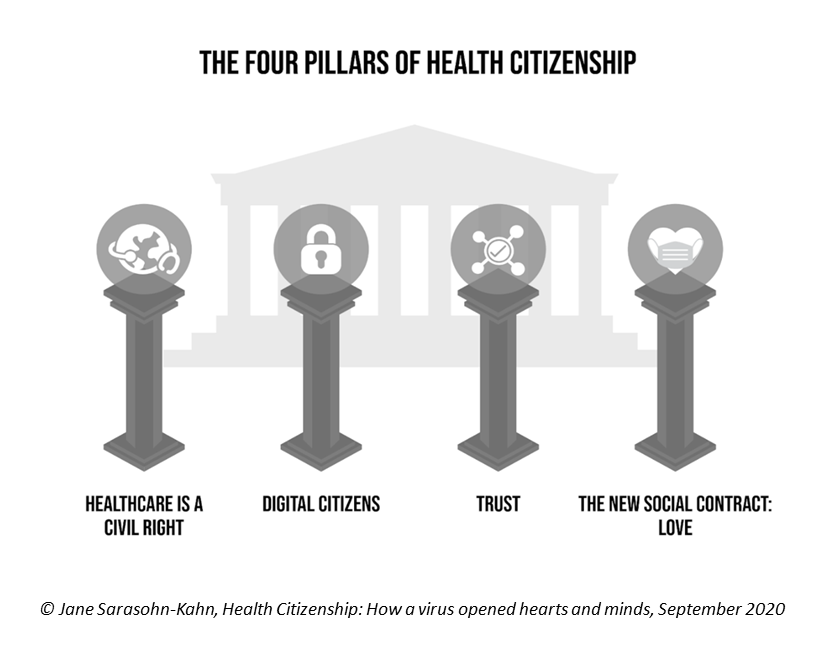
Trust underpins health and civic engagement. And trust is in deficit, at least as important as our nation’s macro-economic deficit will be over time in rebuilding American financial wellness.
In my concept of Health Citizenship, Trust is a key pillar for Americans to “own” their health and wellbeing — along with access to health care as a civil right, protection of our digital privacy, and a new social contract for health….love.
I highly anticipate Known’s next phase of research on the pandemic shock to our human condition. Thanks to the Known team for sharing these insights with us…as we are all on this pandemic journey together to crush this virus and rebuild our home and national economy and social lives.
The post The Pandemic Has Been a Shock to Our System – Learning from Known appeared first on HealthPopuli.com.
The Pandemic Has Been a Shock to Our System – Learning from Known posted first on https://carilloncitydental.blogspot.com
No comments:
Post a Comment